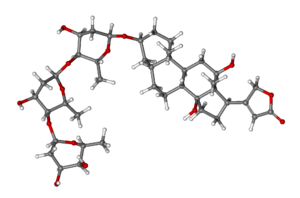Digoxin
 | |
 | |
| Clinical data | |
|---|---|
| Trade names | Lanoxin |
| AHFS/Drugs.com | Monograph |
| MedlinePlus | a682301 |
| Pregnancy category | |
| Routes of administration | Oral, Intravenous |
| ATC code | |
| Legal status | |
| Legal status |
|
| Pharmacokinetic data | |
| Bioavailability | 60 to 80% (Oral) |
| Protein binding | 25% |
| Metabolism | Hepatic (16%) |
| Elimination half-life | 36 to 48 hours (patients with normal renal function) 3.5 to 5 days (patients with impaired renal function) |
| Excretion | Renal |
| Identifiers | |
| |
| CAS Number | |
| PubChem CID | |
| DrugBank | |
| ChemSpider | |
| UNII | |
| KEGG | |
| ChEBI | |
| ChEMBL | |
| E number | {{#property:P628}} |
| ECHA InfoCard | {{#property:P2566}}Lua error in Module:EditAtWikidata at line 36: attempt to index field 'wikibase' (a nil value). |
| Chemical and physical data | |
| Formula | C41H64O14 |
| Molar mass | 780.938 g/mol |
| 3D model (JSmol) | |
| Melting point | 249.3 °C (480.74 °F) |
| Solubility in water | 0.0648 mg/mL (20 °C) |
| |
| |
| (verify) | |
Editor-In-Chief: C. Michael Gibson, M.S., M.D. [1]; Associate Editor(s)-in-Chief: Abdurahman Khalil, M.D. [2]
Synonyms / Brand Names:'''Lanoxin®, Digoxin®, Digox®.
Overview
Digoxin INN is a purified cardiac glycoside similar to Digitoxin extracted from the foxglove plant, Digitalis lanata,[1] which was discovered by William Withering. Its corresponding aglycone is digoxigenin, and its acetyl derivative is acetyldigoxin. Digoxin is widely used in the treatment of various heart conditions, namely atrial fibrillation, atrial flutter and sometimes heart failure that cannot be controlled by other medication.
Category
Cardiac glycoside
Prescribing Information
Lanoxin (digoxin) tablet
Lanoxin injection
Digoxin solution
References
- ↑ Hollman A (1996). "Digoxin comes from Digitalis lanata". British Medical Journal. 312 (7035): 912.
http://dailymed.nlm.nih.gov/dailymed/lookup.cfm?setid=58f45aba-ff6f-43cc-bb88-be40a9f7beda
http://dailymed.nlm.nih.gov/dailymed/lookup.cfm?setid=41c16cff-b03e-405e-a617-d6f45d3ce2bd